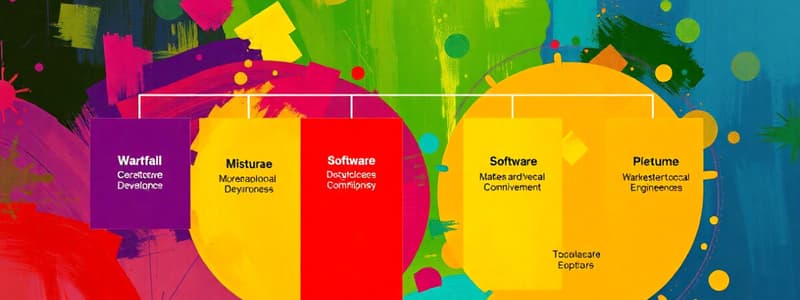Podcast
Questions and Answers
What is a key disadvantage of the waterfall model?
What is a key disadvantage of the waterfall model?
- It requires very minimal documentation.
- It offers real-time feedback during development.
- A working version is available early in the project.
- Specifications can be lengthy and complex. (correct)
Which phase of the software development life cycle is NOT included in the typical software process models?
Which phase of the software development life cycle is NOT included in the typical software process models?
- Requirements phase
- Testing phase (correct)
- Integration phase
- Implementation phase
In which model is the development activity divided into phases with a necessity of documentation for each phase?
In which model is the development activity divided into phases with a necessity of documentation for each phase?
- Evolutionary model
- Rapid prototyping model
- Build-and-fix model
- Waterfall model (correct)
Which model is characterized by the necessity for team members to sometimes wait for others to complete dependent tasks?
Which model is characterized by the necessity for team members to sometimes wait for others to complete dependent tasks?
What is a primary characteristic of the rapid prototyping model?
What is a primary characteristic of the rapid prototyping model?
What is a downside of the build-and-fix model?
What is a downside of the build-and-fix model?
Which model promotes a disciplined approach to software development?
Which model promotes a disciplined approach to software development?
What is one of the features of agile process models?
What is one of the features of agile process models?
Flashcards are hidden until you start studying
Study Notes
Waterfall Model
- Key disadvantage: Limited flexibility – changes in requirements are costly and time-consuming to incorporate, as the process is linear and sequential.
SDLC Phases
- Not included: Deployment and maintenance. While development typically ends with release, it doesn't always end there. Release can occur in phases and maintenance is required to address issues and support software.
Software Process Models
- Necessity for documentation: Waterfall Model - It emphasizes structured documentation and focuses on detailed planning and design.
Team Collaboration
- Dependent Tasks: Waterfall Model - Teams often work in a sequential manner, with one phase building upon the previous. This can lead to delays if one team is waiting for the other to finish.
Rapid Prototyping Model
- Primary characteristic: Early user feedback - It emphasizes creating a working prototype to test and get feedback from users before committing to a full-fledged development effort.
Build-and-Fix Model
- Downside: Lack of proper planning - This model lacks a structured approach, making it challenging to manage complexity, maintain code quality, and address future changes.
Agile Process Models
- Disciplined Approach: Waterfall Model - It has a structured process focusing on well-defined phases, documentation, and reviews, leading to a disciplined and systematic approach to software development.
Agile Process Models
- Feature: Iterative development - Development takes place in short iterations, allowing flexibility and adaptability to incorporate changes and user feedback.
Studying That Suits You
Use AI to generate personalized quizzes and flashcards to suit your learning preferences.




